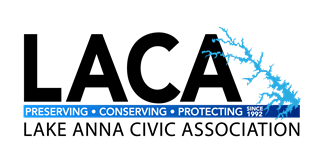By Greg Baker – July 2024
Elections

The LACA elections are live. LACA’s board is made up of 11 volunteers representing the President, Vice President, Secretary, Treasurer and Assistant Treasurer. In addition, members of LACA are represented by one of 6 Regional Directors, each representing members that closely correlate to the county voting districts.
LACA’s board members serve a two-year term and approximately half of the board is up for election each year. With the Vice President, Secretary, Assistant Treasurer and the Regional Directors from Jackson/Cuckoo-Public Side, Brokenburg and Mineral/Louisa up for election in even years. The President, Treasurer and Regional Directors from Jackson/Cuckoo-Private Side, Partlow and Belmont up for election in odd years.
In addition to the voting members of the board, the LACA leadership group also includes the chairs and co-chairs of our various standing committees. These include the Water Quality, Environmental Preservation, Emergency Services & Safety, Land Use, Membership & Marketing, and our Fireworks Committees. (To learn more about one of these committees, please click through to our website.)
You can learn a little more about our leadership group by clicking on the following links:
Board
Committee Chairs
The current election is in process and while we do not have any contested seats, please take the time to vote to show your appreciation for the many hours that our LACA leadership devotes to the community. Voting is limited to the primary member in the household or what is called the “Bundle Coordinator.”
We do have an opening on the board for the Regional Director position for the Jackson/Cuckoo-Public Side. If you reside within this region and are interested in learning more about the role, please email me. You may learn more about the role by clicking here.
Annual Meeting

The LACA annual meeting will be held at a new location on Saturday July 27th, 2024 at The Barn at Callie Oppie’s Orchard on Route 522 very close to the intersection of Route 522 and Route 208 intersection. (The site of the new and much anticipated traffic circle.)
The official meeting will begin at 9:30AM, however please arrive at 9:00 to meet the LACA leadership and spend some time with the committee chairs. A light continental breakfast will be available.
You will hear reports from each of our committee chairs. The election results will be announced, and we will give an update on the $1MM in funding that Lake Anna received from the state to fund the Lake Anna Cyanobacteria Mitigation and Remediation Program.
We also have arranged to have special guest speakers from the Virginia Department of Natural Resources. Stacey Brown, DWR’s boating division director along with Sgt. Alan Hatmaker will speak to DWR’s Perspective on Boating Safety on Lake Anna. This is also an opportunity for us to express support for additional police presence on Lake Anna.
Attendance to the LACA Annual meeting is limited to members in good standing with LACA. To register for the event, you may follow this link. Space is limited so it is important to register in advance of the meeting. If two of you plan to attend, please note that both attendees must register prior to the event. We will attempt to host a Zoom option, but our technology is limited, so we encourage you to attend in person if possible.
What are Bundles and why does it matter?
LACA uses a third-party website host/membership management company, Wild Apricot. Wild Apricot uses terminology of “bundle coordinator” and “bundle member.” A bundle coordinator is the primary member in your household and the only member that is allowed to vote in our elections. LACA allows for each member to represent two members of the same household. The bundle member is that second member.
Why does this matter? If you add a second member to your household membership, that person is also invited to participate in all our surveys that drive LACA leadership’s decisions related to our mandates. In addition, those members may attend LACA events and receive newsletters and E-Grams.
How do you go about adding a bundle member?
1: First make sure that you are able to log into your profile on the LACA website: www.lakeannavirginia.org If you visit our website and see your name at the top of the page, you are logged in and if you click on your name you will be directed to your profile page. If you do not see your name, you will instead see “log in.” To add a bundle member, you will need to log in using the email address you used when you joined LACA. You may need to reset a password if you are unable to log in.
2: Once logged in and you see your name at the top of the web page, click your name and you will be directed to your profile page.
3: Once you are the correct page, you will see “My LACA profile” From there, scroll down to a section called ‘Bundle summary” and you will see a green button “Add member.” From there you may add another member of your household as part of your membership. Please note that your family member must have a unique email address that is different from your own.
4: Finally, your bundle member will need to log in and set up a password for his or her new profile. If you have issues with this process, email me and I will have a member of the LACA leadership group reach out to help.
greg.baker@lakeannavirginia.org

